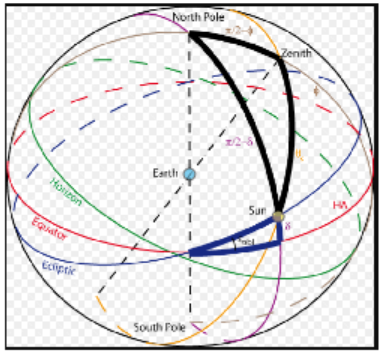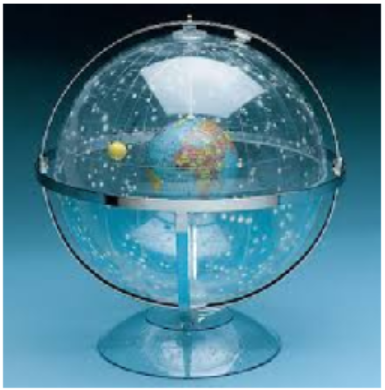Chapter 3 Laws of Sines and Cosines
- \(\displaystyle \blert{\textbf{Obtuse Angles}}\)
- \(\displaystyle \blert{\textbf{The Law of Sines}}\)
- \(\displaystyle \blert{\textbf{The Law of Cosines}}\)

The first science developed by humans is probably astronomy. Before the invention of clocks and calendars, early people looked to the night sky to help them keep track of time. What is the best time to plant crops, and when will they ripen? On what day exactly do important religious festivals fall?
By tracking the motions of the stars, early astronomers could identify the summer and winter solstices and the equinoxes. The rising and setting of certain stars marked the hours of the night.
If we think of the stars as traveling on a dome above the Earth, we create the celestial sphere. Actually, of course, the Earth itself rotates among the stars, but for calculating the motions of heavenly objects, this model works very well.

Babylonian astronomers kept detailed records on the motion of the planets, and were able to predict solar and lunar eclipses. All of this required familiarity with angular distances measured on the celestial sphere.
To find angles and distances on this imaginary sphere, astronomers invented techniques that are now part of spherical trigonometry. The laws of sines and cosines were first stated in this context, in a slightly different form than the laws for plane trigonometry.
On a sphere, a great-circle lies in a plane passing through the sphere’s center. It gives the shortest distance between any two points on a sphere, and is the analogue of a straight line on a plane. A spherical angle is formed where two such arcs intersect, and a spherical triangle is made up of three arcs of great circles.
The spherical law of sines was first introduced in Europe in 1464 by Johann Müller, also known as Regiomontanus, who wrote:
"You, who wish to study great and wondrous things, who wonder about the movement of the stars, must read these theorems about triangles. ... For no one can bypass the science of triangles and reach a satisfying knowledge of the stars."

